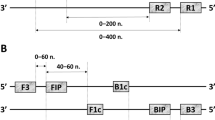Abstract
Specific motifs in the genomes of the Chlamydiaceae family have been sought. The quest for reliable and convenient genetic markers for identification and typing of bacteria remains an urgent task for current molecular biology. Progress in sequencing has resulted in complication of the database of complete genomic bacteria nucleotide sequences. This has made it possible to seek and select genetic targets for identification and genotyping of bacteria based on direct comparative analysis of complete genomic sequences. The current study compares the genomes of the members of the Chlamydiaceae family with the aim of revealing specific nucleotide motifs that could serve as genetic markers of this family. A search for consensus fragments was performed using the Visual Basic for Application software for MS Excel. Complete coincidence of fragments with 25 nucleotide length in the compared genomes was used as the criterion for consensus sequence selection. One complete genomic sequence for each member of eight Chlamydiaceae species was investigated. The experimental set did not include the complete sequence of C. suis since it was missing in the GenBank database for the moment of investigation. Comparison of C. trachomatis genome with other members of the Chlamydiaceae family succeeded in revealing 41 motifs common for all eight investigated Chlamydia species. The highest number of consensus motifs was revealed in ribosomal RNA genes and in tRNA genes. In addition to in rRNA and tRNA genes, consensus motifs were found in five genes and six intergene regions. The consensus motifs in the CTL0299, CTL0800, dagA, and hctA genes detected in the present study may be considered as candidate regions for identification of the Chlamydiaceae family species.
Similar content being viewed by others
References
Demkin, V.V., Mol. Genet., 2010, no. 3, pp. 40–41.
Corsaro, D., Valassina, M., and Venditti, D., Crit. Rev. Microbiol., 2003, vol. 29, pp. 37–78.
Demkin, V.V. and Zimin, A.L., Arch. Microbiol., 2005, vol. 183, no. 3, pp. 169–175.
Everett, K., Bush, R., and Andersen, A., Int. J. Syst. Bacteriol., 1999, vol. 49, pp. 415–440.
Hartley, J.C., Kaye, S., Stevenson, S., et al., J. Clin. Microbiol., 2001, vol. 39, pp. 3072–3079.
Herrmann, B., Peterson, B., Everett, K.D., et al., J. Syst. Evol. Microbiol., 2000, vol. 50, no. 1, pp. 149–158.
Horn, M., Annu. Rev. Microbiol., 2008, vol. 62, pp. 113–131.
Laroucau, K., Souriau, A., and Rodolakis, A., Vet. Microbiol., 2001, vol. 82, no. 2, pp. 155–164.
Pedersen, L.N., Herrmann, B., and Moller, J.K., FEMS Immunol. Med. Microbiol., 2009, vol. 55, pp. 120–130.
Author information
Authors and Affiliations
Corresponding author
Additional information
Original Russian Text © V.V. Demkin, N.V. Kirillova, 2012, published in Molekulyarnaya Genetika, Mikrobiologiya i Virusologiya, 2012, No. 3, pp. 26–28.
About this article
Cite this article
Demkin, V.V., Kirillova, N.V. Specific motifs in the genomes of the Chlamydiaceae family. Mol. Genet. Microbiol. Virol. 27, 117–119 (2012). https://doi.org/10.3103/S0891416812030020
Received:
Published:
Issue Date:
DOI: https://doi.org/10.3103/S0891416812030020




